December 2011 Lichens of Copeland Forest
Because of the warm weather this fall, lichens have been particularly luxurious -noticed by all because the green plants are not distracting. This report and photos are from Troy McMullin, PhD., from University of Guelph, who did an inventory of the lichens of the Copeland forest for the Couchiching Conservancy in October.
“I find myself inspecting little granules as it were on the bark of trees – little shields or apothecia springing from a thallus – such is the mood of my mind – and I call it studying lichens.” Henry David Thoreau
Walking through the forests of southern Ontario the keen observer will notice the gentle splash of colour on the bark and branches of older trees or minute gardens growing on sandy soils and rotting wood, these are typically lichens.
Lichens are composite organisms comprised of two primary partners, a mycobiont (fungus) and a photosynthesizer or photobiont, which is an alga, a cyanobacterium or both. Unlike the tundra and the boreal forest, where lichens often dominate the ground and tree cover, lichens in the forests around Orillia are generally less conspicuous, but the number
of species is no less, nor is their beauty.
During a recent inventory of the lichens in the Copeland Forest many colourful and inconspicuous species were found. Some of the variety in colour is captured in pictures of the following species:
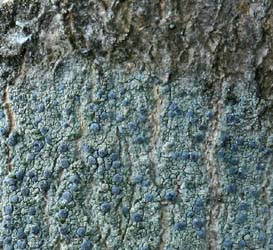
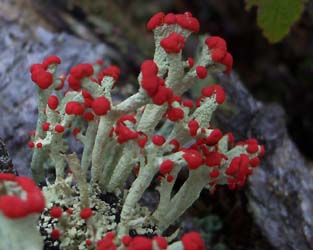
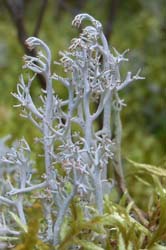
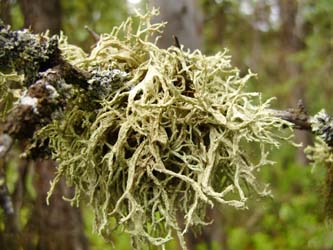
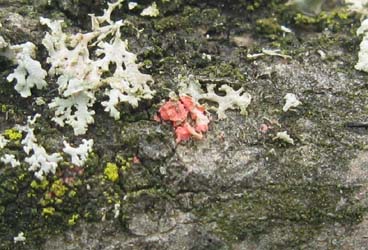
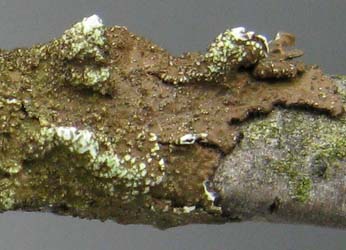
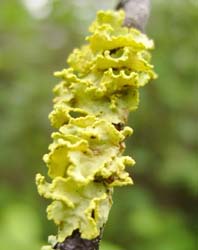
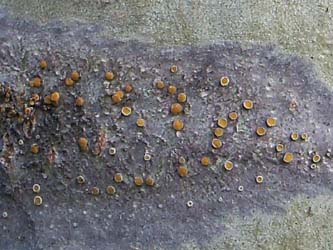
Lichens are sensitive to disturbance and air pollution. One of the reasons for this sensitivity is because they get their nutrients directly from the atmosphere, precipitation and water that washes over them. Unlike vascular plants, lichens lack roots and a waxy cuticle, which allows them to behave like sponges absorbing nutrients in the air. Unfortunately, if pollutants are in the air they will be absorbed as well.
There is a wide range of tolerances to air pollution among different species, which is one of the reasons they are good bioindicators. You won’t see many lichens in the city, only the most pollution tolerant ones, but when you get out to the forest and see them in high abundance, it is a good sign to take a deep breath.
Lichens are the pioneers of plant succession. Since they do not need soil to grow, lichens can colonize bare rock and start the process of turning a barren landscape into a forest. There are 17,500 species currently described by science, with many more yet to be discovered. When you are tuned into the often tiny world of lichens, you will start to see their brilliant diversity on most trees, rocks and soil. So get out there and appreciate the small things in life, and watch your step!
“A thick fog. The trees and woods look well through it. You are inclined to walk in the woods for objects. They are draped with mist, and you hear the sound of it dripping from them. It is a lichen day. Not a bit of rotten wood lies on the dead leaves, but it is covered with fresh, green cup lichens…” Henry David Thoreau
Photos and text by Troy McMullin.
November 2011 Sandhill Crane Staging
Strongville Road, Clearview Township
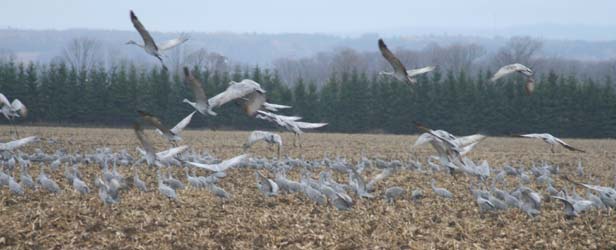
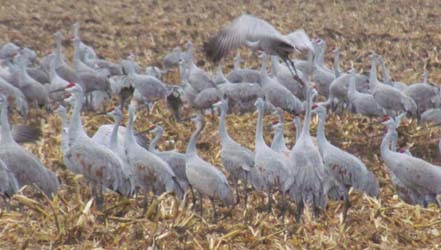
O. E. Devitt (1967) in “ The Birds of Simcoe County” described the Sandhill Crane as “a former transient with only one sighting in modern times”.
Presently the eastern population is expanding in size and breeding range and now Sandhill Cranes can be found locally in Simcoe County from spring to fall and it also breeds here.
Historically, from the 17th Century to the 19th Century, large numbers of cranes stopped in Simcoe County en route to and from their wintering grounds, but that population was extirpated in the 19th Century. However, things have come full circle and once again large numbers of Sandhill Cranes are migrating through Simcoe County.
A staging area is a location where migrating species always stop and feed for short periods, putting on fat, before continuing on their migration. Strongville Road and the surrounding area, which is south of HWY 26 and east of Stayner in Clearview Township has become a staging place
for Sandhill Cranes in the last few years. This fall the numbers of birds began to build in mid-Oct. and by mid-Nov. had reached a peak
of approximately 1000 birds before dispersing and continuing their migration to Georgia and Florida.
The many corn fields in the area attract the cranes to stop and feed but as the corn is cut and harvested and the stubble ploughed under the birds disperse. This area is well worth a visit in late Oct. as the large number of cranes is an impressive sight.
Text by Margo Holt; Photos by Donald Macdonald
October 2011 Cormorants on Lakes Simcoe and Couchiching
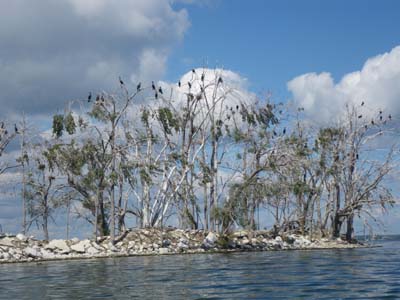
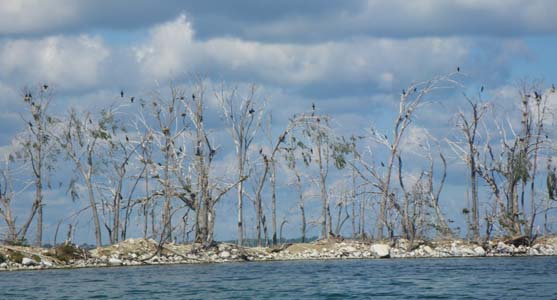
Cormorant Colony on Lake Couchiching (Ship Island). The trees will be able to support nests for some more years.

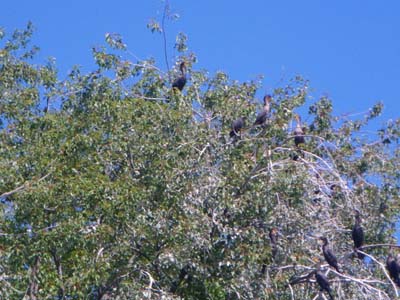
Roosting Colony on Lake Simcoe, near Orillia’s dump. Will the nesting colony eventually move on here?
The largest inland nesting colonies of Double-crested cormorants in south Ontario (excluding the Great Lakes) are on Lake Simcoe, Lake Couchiching and Rice Lake. Foraging flocks occur on the Muskoka Lakes, Kawartha Lakes, Golden Lake and Lake Opeongo.
Cormorants nest on small island rookeries. The whitewash destroys stabilizing plants and other nesting birds are displaced. They use their hooked bill to strip branches. The guano is a hyper fertilizer that wrecks soil chemistry. Trees die in 3 to 10 years.
Cormorants were first seen on Lake Couchiching about 25 years ago.
The rookery on Ship Island in Lake Couchiching has been used for several years now. The destruction of vegetation is very obvious. The cormorants are now roosting in Lake Simcoe along the shoreline of Kitchener Park in Orillia. The white leaves were obvious from the lake this summer. No sign of nests yet. According to the Breeding Bird Atlas, there are 2 roosting sites on the east shore of Lake Simcoe.
The largest colony on the Great Lakes is on the Leslie St Spit. They first arrived in 1990 and in 2009 they numbered 30,000. Some culling has been done by Parks Canada on Lake Erie in Point Pelee National Park on Middle Island where there is an increase in threatened and endangered species.
The dead trees will no longer be able to support the cormorant colony soon,
so they will move from Ship Island. But where? When will our island be rehabilitated? Will the poison ivy, to say nothing of the trees, come back?
Will parts of the Orillia area become become white? or will they just roost here? What is more important- birds or plants or the ecosystem?
Photos and text by Joan Rosebush
September 2011 Great Plains Ladies’ Tresses (Spiranthes magnicamporum) on the Carden Plain
 On Sept. 7, Linda found an orchid on the Carden alvar that was different from the common Nodding Ladies’ Tresses orchid (Spiranthes cernua). She
On Sept. 7, Linda found an orchid on the Carden alvar that was different from the common Nodding Ladies’ Tresses orchid (Spiranthes cernua). She
contacted botanist Mike Oldham, who in turn contacted Spiranthes
expert Paul Catling. They both agreed with Linda’s identification of
Spiranthes magnicamporum (Great Plains Ladies’ Tresses).
This is the first record of this species for the county of City Of Kawartha Lakes. It is a rare plant in Ontario (S3) with previous records from Southwestern Ontario and the Bruce Peninsula. On Sept. 20, I had the
good fortune to observe and photograph this species on the Carden alvar
(25 plants in total at 2 locations).
Some key identification features include: underside of flower lip yellowish (visible in photo), flowers fragrant, lateral sepals spreading and curved resembling a “cow’s horn” (visible in photo), no basal leaves at flowering time.
Because S. magnicamporum closely resembles S. cernua, it is probably overlooked. Any Spiranthes flowering on the Carden alvar in Sept. or later is worth a close look as it may be S. magnicamporum. I would be interested in hearing about any records of this species.
Photo and Report from Margo Holt
August 2011 Hummingbird Banding with Cindy Cartwright in Severn Township
The guest speaker for the March Orillia Naturalist’s Club meeting was Cindy Cartwright, coordinator of the Ontario Hummingbird Project. Cindy is one of only 30 people in Canada who are trained to band hummingbirds, and only 1 of 4 active banders in the country. Cindy started the Ontario Hummingbird Project in 2005 after realizing there had been very little research done on hummingbirds in Canada and the United States.
Cindy’s report:
One of the goals of the Ontario Hummingbird Project is to find places in Ontario with large numbers of hummingbirds coming to feeders so we can find out how long hummingbirds live and how many return to the same location year after year. We were blessed this year when we were invited to a couple’s house to watch and band. It was obvious that there were at least 80 hummingbirds buzzing back and forth, chasing each other and drinking from the numerous feeders around their house. At any given time, there were 16-20 hummingbirds in sight. It was absolutely amazing and was the highlight of our summer!
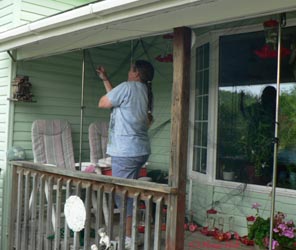
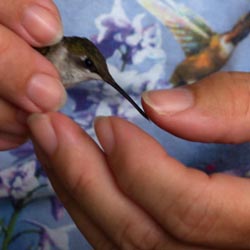

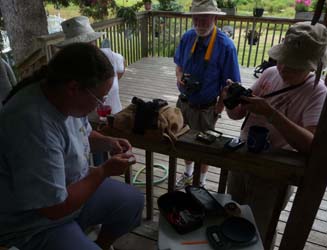
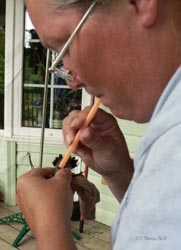
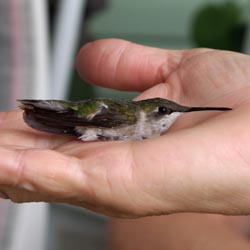
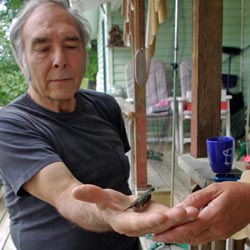
On our second visit, 18 hummingbirds were banded in approximately 2 hours – the most that we have banded at a single location on the same day!
We are grateful that this couple contacted the Ontario Hummingbird Project and invited us to visit them, and we look forward to returning many times in the future.
July 2011 Harvester Butterfly and Woolly Aphids –
The host for the only carnivorous butterfly caterpillar in North America
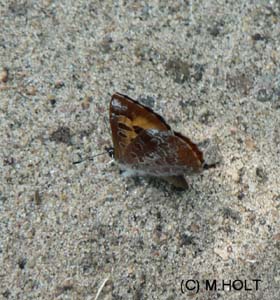
On July 6 a small group of us found a harvester butterfly on a trail near Victoria Bridge. It was in a swampy woodland area, and a moose ( with diarrhea) had recently traversed this trail, as they probably often do, after they stop feeding in a nearby swamp. Since the butterfly’s proboscis is very
short they do not feed on nectar, but instead sip from mud ( because of the chemicals probably), aphid honeydew, dung and sap.
Since the Harvester butterfly is small ( wingspan 23 -32 mm), and usually found singly, they are probably overlooked by butterfly enthusiast who look mainly at flowers.
Margo and Nancy have records of only 4 sightings, and all of them in the 44 degree latitude range.
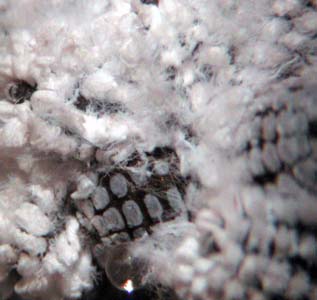
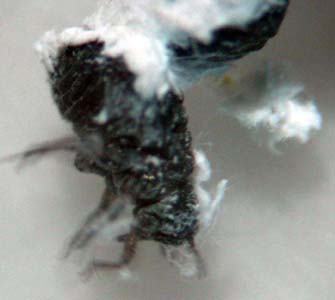
Woolly aphids produce a filamentous waxy white covering which resembles cotton or wool probably to protect them from predators. The harvester butterfly lays its eggs near colonies of woolly aphids -the prey of the larvae. When the caterpillar is formed, these carnivorous larvae eat
the woolly aphids, and may cover themselves, with the remains of the
woolly aphids tied on with the silk of the aphid, possibly as a protection
from the ants that tend the aphids.
Butterfly Photo by Margo Holt. Aphid photos ( through dissecting scope)
and text by Nancy Ironside
JUNE 2011 -THE PURPLE MARTIN STORY
The Atlas of the Breeding Birds of Ontario 2001-2005 reports that the Purple Martin sightings shifted 56 Km to the south from the Atlas done 20 years earlier. Since then we do not know accurately where the northernmost colony remains.
We do know that it is part of the known decline of the aerial insectivores.
Purple martins are North America’s largest swallow. They nest socially in artificial nest boxes, near bodies of large water. Many empty nest boxes are around – boxes that used to host active colonies.
Joan Rosebush has a nest box that is still active on Couchiching Point, near the Narrows in Orillia. This is her report.
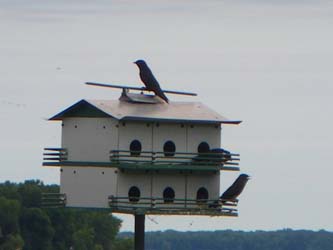
The martins first arrived in the spring of 2004. We first enticed them in to the house by playing the martin song early in the mornings. Four pairs nested and on July 29th there were 15-20 flying and swooping and chattering. The next few years they nested from late April until early August. There were 3 to 6 nests and lots of hustle and bustle as they fed and swooped around.
The first house was a heavy wooden structure that was raised and lowered with great difficulty. The present one is metal and slides up and down like a flag. The balconies are much used. We “talk” to the martins and they know our voices. But strangers beware. The dive bombing is fierce!
In 2010 only 2 pairs nested and the last flyby of about a dozen was July 22 (early).
This year (2011) the first martins arrived April 24th. We recognized a female with odd markings. The next month was very busy opening and closing the holes. The martins had to defend their house against sparrows and starlings. The sparrows would sit outside a hole if the martin went in and peck mercilessly whenever he peeked out. We ripped out many sparrow nests and closed the opening until the martins returned. Finally on May 27th, the martins had won. 3 pairs nested.
July 25th they fledged. About 20 martins chattered and flew about. There are a couple of other nearby nesting houses that joined in the fun. After that the numbers dropped. We would see 2-6 stop at the house and feed above.
But then on August 4th, we decided to see why martins were still around. Surprise!!! Another family was still there. There were 3 or 4 unfeathered black nestlings. We quickly sent them back up for feeding.
August 12th still has the parents feeding this late batch. A few martins fly overhead daily. 2013 – 3 active and successful nests. The martins left August 6, Joan reports.
NEW LOCATION:
Craig Barrett reports from MacIsaac Drive on Lake Simcoe , near the narrows ( Smith’s Bay):
The purple martin house came to Orillia in the spring of 2007 and hosted its first 3 pairs. Two years later, after seasons of similar nesting rates, I was able to add a two decker unit, acquired from a neighbour, who did not want it, and immediately it had several pairs. Last year ( 2013) I estimate we had 10 successful nests and fledged 20 young. This year ( 2014) I have added the gourd, and cable for perching, and today it appears to have a tenant. The first scout appeared on Saturday April 26th and many more have arrived since.
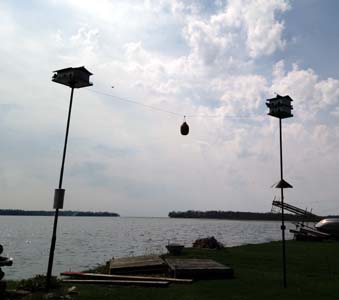
We will continue to update the Purple martin story in Orillia.
May 2011 3 species of bumblebees seen on May 29, on Ajuga
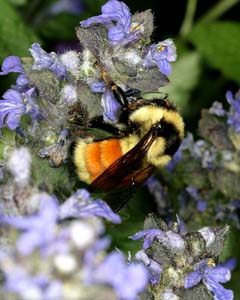
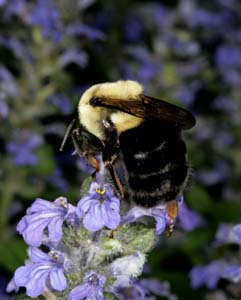
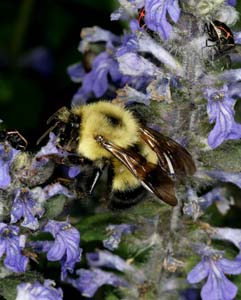
Al Sinclair reports and identifies:
About 10 bumblebees of 3 species were on Ajuga reptans (Bugleweed, Bugle Carpet, Carpet Bugleweed, Carpetweed)
in Joan’s flower bed today.
Ajuga was the most popular of all the perennials here currently blooming. ( It is an invasive alien commonly found in gardens)
Photos taken May 29, 8km east of Bracebridge, by Al Sinclair.
The Bumble Bees of Algonquin Provincial Park, A Field Guide can be purchased through the Algonquin Park Bookstore for $10
April 2011 Buxbaumia aphylla – Bug on a stick
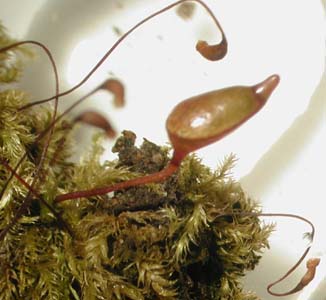
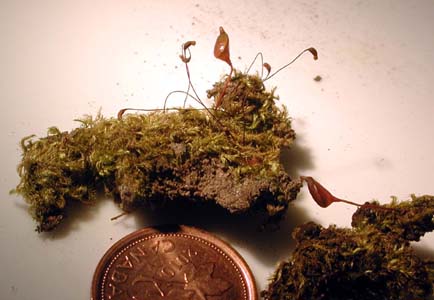
During April showers, before they bring out the May flowers, we are grateful for the mosses –lush greens in a beige shaded forest. In fact, Bryologists choose to search for their mosses and lichens at the shoulder seasons, when they are not distracted by flowers and other greens.
A rare find (and new to the Simcoe County moss list) is Buxbaumia aphylla. Because of its size, it is easily overlooked. It seems to be mainly just a large sporophyte ( the spore bearing part of the moss), no (or inconspicuous) leaves, just protenema underground.
Surprisingly it has both male and female structures. In this case it was growing with another moss, producing sporophytes ( shown in the photo),
and this caught my attention.
Buxbaumia may be saprophytic. It is possible that some of its nutritional needs are met by fungi that grow within the plant, or it may cooperate with a leafy liverwort for its chlorophyll.
The sporophyte begins its development in the autumn, and is green through the winter months. Spores are mature and ready for dispersal by the late spring. (This photo was taken in early April.) The spores are ejected from the capsule in puffs when raindrops fall upon the capsule’s flattened top. When first encountered 275 years ago, it was not known how to classify it – fungus, moss, lichen?, and this discussion continued for some years.
It occupies disturbed habitats, such as soil banks beside paths.
It was exciting to find it in Matchedash, because it is so unusual, and has such an unusual life style. What is its role in the ecosystem? There are so many things we don’t know, even though we act as if we are free to tinker with our environment.
Photos and text by Nancy Ironside
MARCH 2011 WINTER STUDIES: YELLOW-BELLIED SAPSUCKER HOLES, A TREE AND A FUNGUS
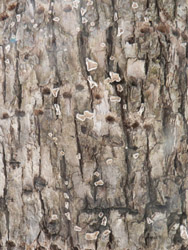
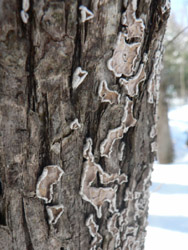
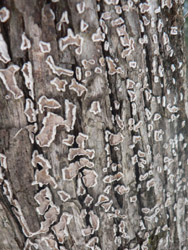
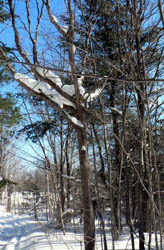
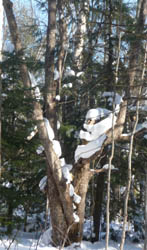
THE TREE: IRONWOOD
on the left a large , healthy tree, and on the right, a very old, partly broken, but still living tree. We identified the fungus on this tree in 2006.
Plot 1, which is my property in Matchedash, ( Lat 44 47 and Long 79 35 ) was the initial site studied, and casual observations there led to our winter project.
Yellow-bellied Sapsucker holes have been observed in this area so frequently on Eastern Hemlock trees that we considered the holes diagnostic of this commonly found tree. These holes are usually found in rows, most often horizontally, but often vertically, as well as casual holes sprinkled throughout. The holes are commonly at eye-level, and above, and can be found almost to the snow-covered base. The sapsucker is looking for the phloem (sap), which attracts insects, especially ants. The bird bundles up the ants in the phloem, and flies the food to the nestlings. It is reported that the birds reopen these holes when they return in the spring. Most local observers would be aware of these holes –there is even an interpretive sign at Grant’s Woods.
We studied the Ironwood, or Hop Hornbeam Tree. The bark is grayish, and loose at both ends. According to “Trees in Canada”, they are small trees, up to 12 meters high and 25 cm (9.8 inches) in diameter, occasionally larger.
The fungus was Aleurodiscus oakesii, which is rarely reported. Until this winter we only knew of 2 sites in our area near Orillia. According to Tom Volk (Fungus of the Month) Aleurodiscus oakesii is a small but a very commonly overlooked crust fungus. The food source for the fungus is actually the dead bark of the tree – a saprophyte. The outer bark of woody trees is no longer functioning in the transport of sugars. This task is taken by the inner bark with its functional secondary phloem. While this fungus is reported to grow on oak trees, it is most commonly found in the Northeastern USA on Ironwood trees (report of Sam Ristich from Maine).
Our fungus was confirmed by Bernhard de Vries of the Netherlands.
We also noted that the large Ironwood trees with this fungus were covered with Yellow-bellied Sapsucker holes.
HYPOTHESIS: The fungus made the tough tree suitable for Yellow-bellied sapsuckers. The question: must the Hop-hornbeams be infected before the YBSS is interested, or is the size of the tree the determining factor for both the fungus and the bird, with no relevance to each other?
OBSERVATIONS: YBSS holes were found on Eastern Hemlocks, American Elms, and Ironwoods. We only looked at and measured trees easily accessible beside the trails because of the snow cover. The depth of the holes, as measured was about 0.3 cm..
Hemlocks appear to be the preferred trees for YBSS, both in groves and singly. They prefer mid size trees 10.8 – 14.6 inches diameter at breast height(DBH).
Almost all hemlocks in this size range have been used by the birds. Most holes are horizontal lines, occas. some vertical lines, but also random holes.
3 American Elms with a circumference of greater than 12.8 inches DBH were found with abundant holes, often horizontally, as well as random holes. Because of the Elm die off in the last 30 years, there were few trees to study.
Ironwoods (Hop-Hornbeams) are also used. There were 2 large trees with abundant holes. First tree was split near to the ground, and each trunk was measured 18.8 inches (DBH) and 14.9 inches (DBH).
Another tree was measured at 8.91 inches (DBH). Both these trees were abundantly covered with Aleurodiscus oakesii. Although we had not previously realized it, there are many more Ironwoods when we continued on the trail, which are favoured by YBSS. YBSS holes were found on all trees greater than 8.28 inches DBH. Although trees greater than 5.09 (DBH) had no holes, most of this size had the saprophytic fungus.
CONCLUSION:
Ironwoods are favoured trees for Yellow-bellied sapsucker holes, and for Aleurodiscus oakesii but their use depends on the size of the tree, rather than the presence of the fungus. (Nevertheless, no Ironwoods that were not host trees to the fungus were used by the Sapsuckers, so maybe .. )
Studies by Nancy Ironside, with assistance from Mary and Omer Mick, Joan Rosebush, Wendy Hutchings, Ellen Dennig, Leonore Wianko and Margo Holt (who is especially involved in the literature search). Editorial assistance from Tony Wright ( Mycological Society of Toronto)
FEBRUARY 2011
OVERWINTERING PINE WARBLER – A TOUGH LITTLE GUY, I HOPE
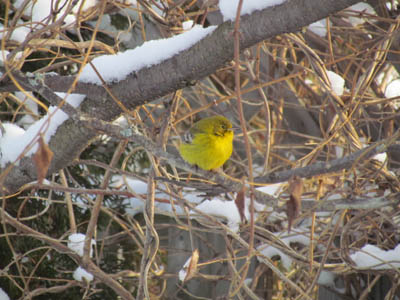
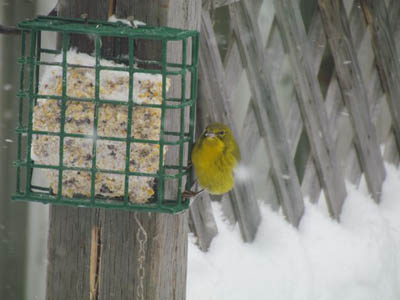
Shirley Donald sent us these photos, and her comments, which follow. “You’ll be glad to know the warbler is doing OK. I’ve had Cooper’s hawk, Northern Shrike, -28′ weather but he so far has not been eaten, frozen,or starved. He likes the suet and wild finch seed and comes several times a day. The female towhee is holding her own as well.”
This bird, which was recorded on the Xmas bird count, was new for the winter list. The northern race of Pine Warbler (that includes Ontario breeding birds) are short-distance migrants and mainly winter in the
southeastern United States, with a few reaching northeastern Mexico, Bermuda, and Cuba. It is one of the first warblers to arrive in the spring,
arriving together with, or even before, the Yellow-rumped Warblers. It is one of the earliest breeding warblers too, starting in late April or May. I hope he finds a friend who will appreciate him.
update: March 28 -he is still alive and well.
December 19/2015 Xmas bird count recorded (and photographed) another Pine Warbler at a feeder off the Horseshoe Valley Road. Will it survive the winter?
JANUARY 2011
The Ermine ‘A seldom seen little carnivore’
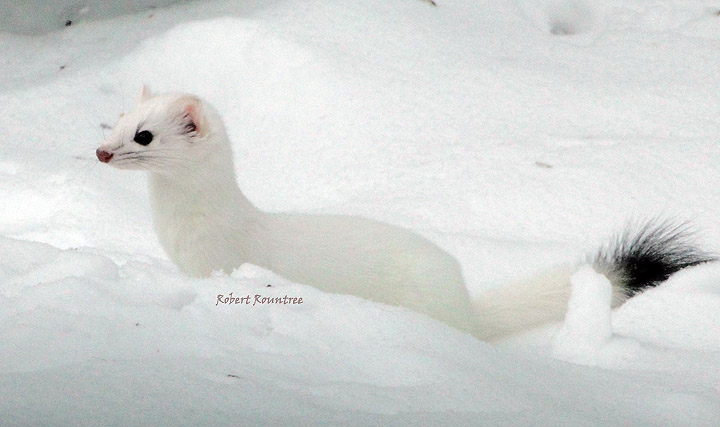
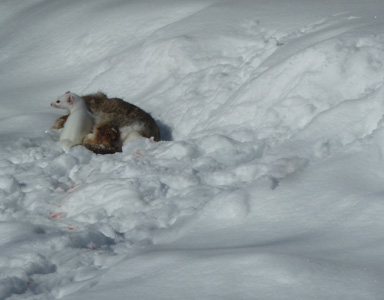

Some lucky people living near the Copeland Forest in Oro-Medonte have an Ermine ( Mustella erminea) incorporating the area around their bird feeders in its foraging territory both this winter and last. The Ermine, also called Short-tailed Weasel, is taking advantage of the small rodents attracted to the feeder area.
The winter white coat is brought about by a molt controlled by photoperiod, temperature, and hormones. Of course the advantage of a white coat in winter is camouflage to aid in hiding from predators. The black tail tip is thought to have evolved to divert the strike of predators away from the more vulnerable head and body. Interestingly, Ermines living in more southern latitudes do not turn winter white but remain brown all year.
There would be no ecological advantage to being white in latitudes where there is no snow.
Thanks to Bob Rountree for the photos and to Margo Holt for the text
March 3 2015:
 Kyra Howes sent several photos of an ermine that she watched, catching a large rabbit, and pulling it away, dead, to the woodpile.
Kyra Howes sent several photos of an ermine that she watched, catching a large rabbit, and pulling it away, dead, to the woodpile.
